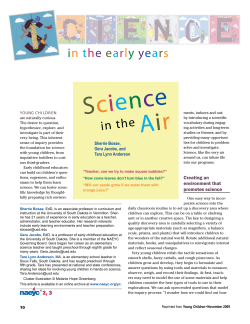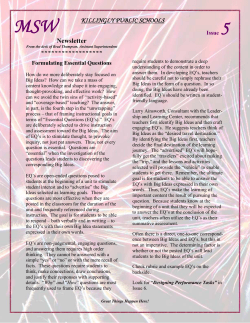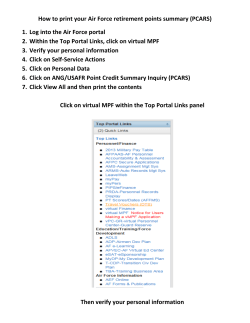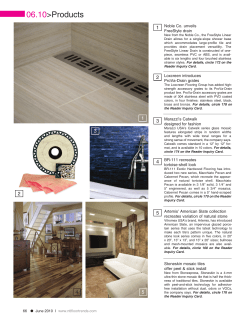
Appreciative Inquiry Handbook
Lunch and Learn Presentation: Appreciative Inquiry Presenter: Gina Lawson, RHP 8 Program Assistant Tuesday, September 23, 2014 12:00 – 1:00 p.m. 1 Introductions Presentation Outline ◦ Learning Objectives: Describe Key Concepts of Appreciative Inquiry (AI) Identify AI resources ◦ Quality Improvement and Assurance Overview ◦ Appreciative Inquiry Overview ◦ Resources/Examples ◦ Q&A 2 Create an engaging and exciting collective vision? Enhance the sense of community and creativity? Build upon leadership skills and train future leaders? Open the lines of communication and collaboration between staff, patients and stakeholders? Work toward sustainability? Appreciative Inquiry (AI) applications and resources can help you and your organization accomplish these goals and much more. 3 Quality Assurance (QA) finds problems in performance. Quality Improvement (QI) fixes problems in performance. Courtesy of Hunter Gatewood, Improvement Advisor, Signal Key Consulting Signal Key Consulting 4 AI is an approach for engaging staff at all levels to produce effective, positive change as a continuous quality improvement (CQI) tool. AI begins by identifying what is positive and connecting it in ways that heighten energy, vision, and action for change. Cooperrider, David L., Diana Whitney, and Jacqueline M. Stavros. Appreciative Inquiry Handbook - For Leaders of Change. 2nd ed. Brunswick: Crown Custom, 2008. Print. 5 Positive Core 6 Discovery Dream Design Destiny 7 8 Stated in the positive Objectives staff want to accomplish and learn more about 9 Which team would you like to be on? A or B 10 1. What would you describe as being a peak experience or high point in your life-personal or professional? 2. What do you value most about yourself? Your work? Your organization? 3. What is the core factor that gives life to your organization? 4. Describe your vision of the future for the organization and your world. Cooperrider, David L., Diana Whitney, and Jacqueline M. Stavros. Appreciative Inquiry Handbook - For Leaders of Change. 2nd ed. Brunswick: Crown Custom, 2008. Print. 11 NOVELTY Managing: Curiosity, Dreams & Changing the Process A Healthy Organization CONTINUITY TRANSITION Managing: Core Values, Strengths, Minimal Disruption Managing: Next Steps, Feedback, Celebrating Progress 12 1. Our organization will use AI because we want to ______________ in order to ______________. 2. Who will lead this AI initiative? 3. What is the time frame for the effort? 4. How many people and who will be involve? 5. How will we select the affirmative topics for the inquiry? 6. How many interviews will we conduct and who will conduct them? Other questions included on worksheet. Cooperrider, David L., Diana Whitney, and Jacqueline M. Stavros. Appreciative Inquiry Handbook - For Leaders of Change. 2nd ed. Brunswick: Crown Custom, 2008. Print. 13 Staff/Management Training & Development Customer Satisfaction Team Development Strategic Planning Work Process Redesign 14 1. Reflecting on your experience, describe a time when you partnered with one or more people to complete a project. What are some principles or values that made the experience a positive and productive one? What contributions made you most proud of and satisfied with the partnership. Adapted by Cardea Services with permission from Miller, Carolyn J., and Cristina R. Aguilar. The Nonprofits Guide to the Power of Appreciative Inquiry. Denver: Community Development Institute, 2004. Print. 15 2. Describe a time when your organization partnered with another agency to enhance services for the community you serve. What was the purpose of the project? Who were the other agencies involved? Who benefitted from the partnership? What made the partnership and project successful? What strategies did the partners use to create unity, shared understanding and common purpose? Adapted by Cardea Services with permission from Miller, Carolyn J., and Cristina R. Aguilar. The Nonprofits Guide to the Power of Appreciative Inquiry. Denver: Community Development Institute, 2004. Print. 16 3. Dream into the future…Three years from now your organizations have successfully partnered to enhance your services. What are the issues that have improved as a result of the partnership? In a speech talking about this collaboration, identify three underlying principles that enabled each partner to feel it shared in a “win-win” partnership. Adapted by Cardea Services with permission from Miller, Carolyn J., and Cristina R. Aguilar. The Nonprofits Guide to the Power of Appreciative Inquiry. Denver: Community Development Institute, 2004. Print. 17 United Nations Cooperrider, David L., Diana Whitney, and Jacqueline M. Stavros. Appreciative Inquiry Handbook - For Leaders of Change. 2nd ed. Brunswick: Crown Custom, 2008. Print. 18 Cooperrider, David L., Diana Whitney, and Jacqueline M. Stavros. Appreciative Inquiry Handbook - For Leaders of Change. 2nd ed. Brunswick: Crown Custom, 2008. Print. Miller, Carolyn J., and Cristina R. Aguilar. The Nonprofits Guide to the Power of Appreciative Inquiry. Denver: Community Development Institute, 2004. Print. Appreciative Inquiry Commons: Case Western Reserve University ◦ Weatherhead School of Management Appreciative Inquiry at Case Western University ◦ AI in the Health Care Sector Appreciative Inquiry in Health Care at Case Western 19 Building Capacity for Better Work and Better Care: Pennsylvania Community Hospitals and Medical Centers Cooperrider, David L., Diana Whitney, and Jacqueline M. Stavros. Appreciative Inquiry Handbook - For Leaders of Change. 2nd ed. Brunswick: Crown Custom, 2008. Print. 20 Gina Lawson RHP 8 Program Assistant glawson@tamhsc.edu 512-341-4975 “Continue to seek ways to gain a deeper understanding of those things that give life to an organization and its people.” Excerpt from Hunter Douglas Window Fashions Division AI result outcome. Cooperrider, David L., Diana Whitney, and Jacqueline M. Stavros. Appreciative Inquiry Handbook - For Leaders of Change. 2nd ed. Brunswick: Crown Custom, 2008. Print. 21
© Copyright 2025











